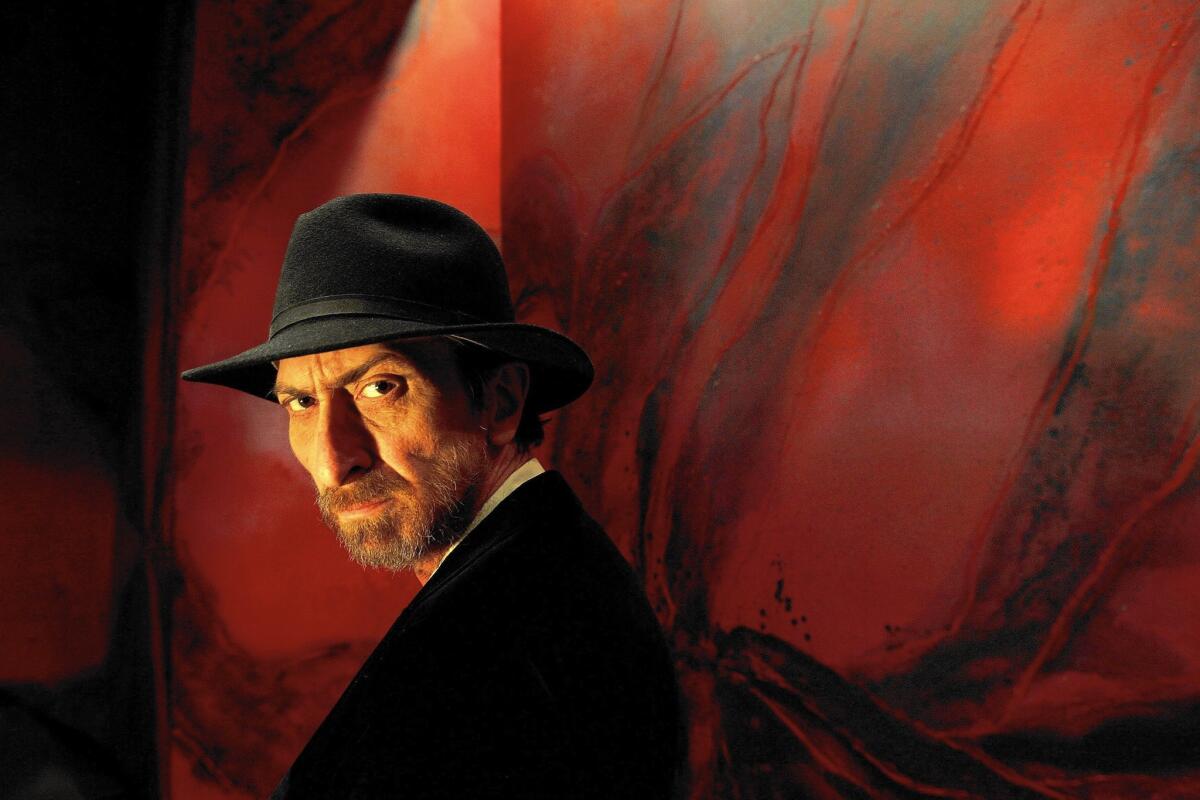Frank Miller has more in store for Batman

Famed writer-artist Frank Miller will be signing the 30th anniversary reissue of “The Dark Knight Returns” on Saturday, Feb. 20, at Legacy Comics in Glenadle.
- Share via
Batman has been a character of many faces over the decades, from his hard-boiled birth in 1939 to his evolution into a campy crime fighter of 1960s pop, then his subsequent return to brooding urban vigilante in a bat suit. That legacy has come through the efforts of generations of creators at DC Comics, but none have had a more lasting impact than writer-artist Frank Miller.
In 1986, his four-issue comic “The Dark Knight Returns” imagined a middle-aged Bruce Wayne bruised and hardened in a society gone mad and a world on the verge of war, as Batman returns from retirement to battle “Mutant” street gangs and a Superman who has become a blind servant of the U.S. political class. It was dark and controversial, and it pushed the boundaries of what a Batman story could be. Its impact could also be seen in Batman film adaptations by Tim Burton and Christopher Nolan and now in movie trailers for the upcoming “Superman v Batman: Dawn of Justice.”
NEWSLETTER: Stay up to date with what’s going on in the 818 >>
“Batman is smarter than anyone else. He’s got the best toys in the world. And he’s the angriest man on the planet,” Miller said in an interview with Marquee this week. He’s enjoyed success with his original comics, including “Sin City” and “300,” and he’s become a film director, but Batman and DC keep calling him back. “All these characters bring a terrific joy in the wish fulfillment that they offer. Any good dream is a wish, and any good superhero still is a wish come true.”
“The Dark Knight” has now been reissued in a 30th anniversary edition, which Miller will be signing at noon Saturday, Feb. 20, at Legacy Comics in Glendale. He’ll be joined there by Andy Kubert, the artist collaborating with Miller on “Dark Knight III: The Master Race,” the author’s third in the series. (Later on Saturday evening, Miller will also appear at the Barnes & Noble at the Grove in Los Angeles.)
Marquee: Batman is a character that you never quite get way from. There must be a reason for that.
Frank Miller: I suppose there is. Maybe I think like a bat or something. I’ve always had an affinity for the character because my imagination runs into some pretty dark corners. And Batman, of all the superheroes, has always been the scary one.
Because you could imagine him actually existing?
That’s part of the reason. As conceivable as he is — I could dress up like a bat and do what he does — the thing that makes him most exciting to me is that at the same time that he’s much scarier than the rest, he’s mythic. He seems ageless. He comes out of the shadows and attacks. He’s not like Superman, where he flies around dressed as a flag and is easy to see. You don’t know where Batman’s going to come from or what he’s going to do.
How would you distinguish what you do under the “Dark Knight” title and other Batman comics that you’ve done?
“The Dark Knight” was my ticket to freedom. I was able to do Batman as I’ve seen him. When I do Batman now it’s my version. I’m given a lot of leeway. The character is wonderfully adaptable to the times. There’s the version from the 1940s compared to the ‘50s and compared to the ‘60s and the Adam West show. They’re altogether different. Mine was just updated for the ‘80s and ‘90s.
My relationship with DC has always been very, very good. When I first did “Dark Knight” it was turbulent trying some new things out, but that’s the normal tension that happens between your publisher and the writer. There’s bound to be give and take as you hash things out.
There has been about a 15-year gap between each of your “Dark Knight” series.
It takes me a while to get as angry as he is. The character is one I can redo any old time. It’s about finding the right time and everybody’s schedules being open, and having the right people in place who want to get more daring. All these things have to combine at the right time. First of all, the story has to pop into my head.
The “Dark Knight” stories aren’t just about Batman but are really also your chance to deal with Superman in a different way.
I loved Superman ever since I was a little boy and watched the old World War II Fleischer cartoons on black and white TV. Those were my first exposure to superheroes ever. I love Superman. In the world of Batman I give Superman an extremely hard time, and I love playing with the DC superhero trilogy, which is Batman, Superman and Wonder Woman. They form a trio of gods that mortals have to deal with.
Trailers for the upcoming “Superman v Batman” show a Batman wearing armor in his battle with the Man of Steel. A lot of comics fans know that image originated in your “The Dark Knight.”
He had to, didn’t he? In “Dark Knight,” for obvious reasons, if he was going to take on Superman he better gear up a bit. Whenever I work on DC characters, it’s part of the understanding that I’m doing a collective work, and it’s one that had people before me and people after me, and when I add something to it, it becomes fair game for them to use in their stories, which they obviously do.
Your original “The Dark Knight Returns” is being celebrated with a new edition for its 30th anniversary, as it was for the 20th. It’s among a select few that receive that kind of ongoing recognition. When did you realize interest in the work would live on?
You can’t predict this sort of thing. You get lucky. You just do the best job you can, and if people like it you’re overjoyed, and you make lots of money from it ... and if they like [it] enough to come back again in this new edition, then you’re like a kid at Christmas.
What do you hear from fans when you do a signing?
If I try something new, I’ll hear a variety of reactions, good and bad. The one thing everyone seemed to like right off the bat was the fact that I’d turned Robin into a girl. That was real popular. Making Batman meaner, that was something a lot of the audience didn’t like at first, and then came to like later. My work tends to be a little extreme to a lot of people — they either like it a lot or they don’t.
You often bring the culture and politics of the time into the storytelling — back in the ‘80s the talking head on TV was Ted Koppel, now it’s Bill O’Reilly.
Comics are first and foremost a lot of fun. It can be applied to anything. And one thing comics are very, very good at is politics. Editorial cartoons in newspapers are proof of this. I love to read about politics and I love to write satire. Naturally politics plays into my stories.
Do you foresee returning again in the future to Batman?
You know, each time I’ve thought that this is it. Now I know that it’s not. I’ll be back.
--
What: Frank Miller with Andy Kubert
Where: Legacy Comics and Cards, 123 W. Wilson Ave., Glendale
When: Saturday, Feb. 20, noon to 2 p.m.
More info: (818) 247-8803, legacycomics.com
--
What: Frank Miller, signing and discussion
Where: Barnes & Noble at The Grove, 189 The Grove Drive, Los Angeles
When: Sat., Feb. 20, 7 p.m.
More info: (323) 525-0270
--
Steve Appleford, [email protected]
Twitter: @SteveAppleford
